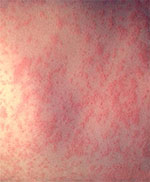What did YOU get at Disneyland? Measles?

Is the “Happiest Place on Earth” becoming the most contagious?
The Centers for Disease Control is reporting that they are investigating a multi-state outbreak of measles associated with travel to Disneyland Resort Theme Parks (which includes Disneyland and Disney California Adventure). The outbreak started in December 2014 and as of January 21, 51 confirmed cases of measles linked to this outbreak have been reported- 42 from California and 9 from six other states (3 in UT, 2 in WA, 1 in OR, 1 in CO, 1 in NE, and 1 in AZ). More are expected over the next few weeks.
Measles was declared eliminated in the United States in 2000, because of high population immunity achieved by high 2-dose measles vaccine coverage and a highly effective measles vaccine. However, measles is still endemic in many parts of the world, and outbreaks can occur in the U.S. when unvaccinated groups are exposed to imported measles virus.
Of those who contracted measles after a visit to Disneyland, 28 (55%) were unvaccinated, 17 (31%) had unknown vaccination status, and 6 (12%) were vaccinated. Of the 6 cases vaccinated, 2 had received 1 dose and 4 had received 2 or more doses. Among the 28 unvaccinated cases, 5 were under age for vaccination. Eight patients required hospitalization.
Dr. Gil Chavez, deputy director of the California Department of Public Health, says people are opting out of vaccines by choice.
“When you look at populations that have higher rates of lack of vaccinations, they are not communities that are disenfranchised with no access to care. They tend to be more affluent communities”
Some parents fear a link between vaccines and autism, a connection which has been soundly dismissed by many scientific studies.
What is measles?
Measles is a highly contagious respiratory disease caused by a virus. It spreads through the air through coughing and sneezing. Measles starts with a fever, runny nose, cough, red eyes, and sore throat, and is followed by a rash that spreads all over the body. About three out of 10 people who get measles will develop one or more complications including pneumonia, ear infections, or diarrhea. Complications are more common in adults and young children.
The symptoms of measles generally appear about seven to 14 days after a person is infected.
Measles typically begins with
- high fever
- cough
- runny nose
- red, watery eyes (conjunctivitis)

Measles rash
Two or three days after symptoms begin, tiny white spots (Koplik spots) may appear inside the mouth.
Three to five days after symptoms begin, a rash breaks out. It usually begins as flat red spots that appear on the face at the hairline and spread downward to the neck, trunk, arms, legs, and feet. Small raised bumps may also appear on top of the flat red spots. The spots may become joined together as they spread from the head to the rest of the body. When the rash appears, a person’s fever may spike to more than 104° Fahrenheit.
After a few days, the fever subsides and the rash fades.
What are the complications of measles?
Measles can be a serious in all age groups. However, children younger than 5 years of age and adults older than 20 years of age are more likely to suffer from measles complications.
Common Complications
Common measles complications include ear infections and diarrhea.
- Ear infections occur in about one out of every 10 children with measles and can result in permanent hearing loss.
- Diarrhea is reported in less than one out of 10 people with measles.
Severe Complications
Some people may suffer from severe complications, such as pneumonia (infection of the lungs) and encephalitis (swelling of the brain). They may need to be hospitalized and could die.
- As many as one out of every 20 children with measles gets pneumonia, the most common cause of death from measles in young children.
- About one child out of every 1,000 who get measles will develop encephalitis (swelling of the brain) that can lead to convulsions and can leave the child deaf or mentally retarded.
- For every 1,000 children who get measles, one or two will die from it.
What is the best way to prevent measles?
Measles can be prevented with the MMR (measles, mumps, and rubella) vaccine. More than 95% of the people who receive a single dose of MMR will develop immunity to all 3 viruses. A second vaccine dose gives immunity to almost all of those who did not respond to the first dose. Note that although the vaccine is one of the most effective vaccines available today, there is still a very small percentage of people that do not mount a sufficient response to the MMR vaccine and may be at risk for contracting measles (explaining those few people who still got measles even though they were vaccinated).
The safety record of the MMR vaccine is very good. Most children who get the vaccine do not have any problems. As with all medicine, some problems – usually very minor – can happen. The MMR vaccine sometimes causes pain where the shot is given, fever, a mild rash, or swelling of the neck or check. On very rare occasions, the vaccine’s ingredients cause severe (anaphylactic) allergic reactions. In addition, the MMR vaccine has been linked with a very small risk of febrile seizures (seizures or jerking caused by fever). This happens most often in children between 12-23 months old.
Vaccine Recommendations
Children
CDC recommends all children get two doses of MMR vaccine, starting with the first dose at 12 through 15 months of age, and the second dose at 4 through 6 years of age. Children can receive the second dose earlier as long as it is at least 28 days after the first dose.
Students at post-high school educational institutions
Students at post-high school educational institutions who do not have evidence of immunity against measles need two doses of MMR vaccine, separated by at least 28 days.
Adults
Adults who do not have evidence of immunity against measles should get at least one dose of MMR vaccine.
Source: Centers for Disease Control




























0 comments